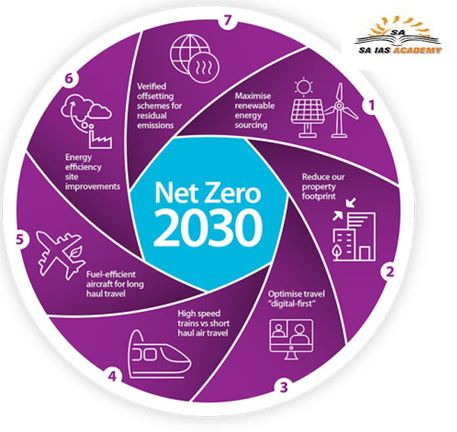Carbon neutrality
Carbon neutrality is a state of net-zero carbon dioxide emissions. This can be achieved by balancing emissions of carbon dioxide with its removal (often through carbon offsetting) or by eliminating emissions from society (the transition to the “post-carbon economy”) The term is used in the context of carbon dioxide-releasing processes associated with transportation, energy production, agriculture, and industry.
Although the term “carbon neutral” is used, a carbon footprint also includes other greenhouse gases, measured in terms of their carbon dioxide equivalence. The term climate-neutral reflects the broader inclusiveness of other greenhouse gases in climate change, even if CO2 is the most abundant. The term “net zero” is increasingly used to describe a broader and more comprehensive commitment to decarbonization and climate action, moving beyond carbon neutrality by including more activities under the scope of indirect emissions, and often including a science-based target on emissions reduction, as opposed to relying solely on offsetting.
Independent charitable organization Oxfam has said that ‘net zero’ carbon targets that many countries have announced may be a “dangerous distraction” from the priority of cutting carbon emissions.
“Land-hungry ‘net zero’ schemes could force an 80 per cent rise in global food prices and more hunger while allowing rich nations and corporates to continue “dirty business-as-usual,” Oxfam has said in a new report titled “Tightening the Net” that has been released just a few months ahead of the UN climate talks in Glasgow.

Net-zero mean
Net-zero, which is also referred to as carbon-neutrality, does not mean that a country would bring down its emissions to zero. That would be gross-zero, which means reaching a state where there are no emissions at all, a scenario hard to comprehend. Therefore, net-zero is a state in which a country’s emissions are compensated by absorption and removal of greenhouse gases from the atmosphere.
One way by which carbon can be absorbed is by creating carbon sinks. Until recently, the Amazon rainforests in South America, which are the largest tropical forests in the world, were carbon sinks. But eastern parts of these forests have started emitting CO2 instead of absorbing carbon emissions as a result of significant deforestation.
This way, it is even possible for a country to have negative emissions, if the absorption and removal exceed the actual emissions. Bhutan has negative emissions, because it absorbs more than it emits.
The report says that if the challenge of change is tackled only by way of planting more trees, then about 1.6 billion hectares of new forests would be required to remove the world’s excess carbon emissions by the year 2050.
Further, it says that to limit global warming below 1.5°C and to prevent irreversible damage from climate change, the world needs to collectively be on track and should aim to cut emissions by 45 per cent by 2030 from 2010 levels, “with the sharpest being made by the biggest emitters.”
Currently, countries’ plans to cut emissions will only lead to a one per cent reduction by the year 2030. Significantly, if only land-based methods to deal with climate change are used, food rises are expected to rise even more. Oxfam estimates that they could rise by 80 per cent by the year 2050.
“Oxfam’s report shows that if the entire energy sector -whose emissions continue to soar- were to set similar ‘net-zero’ targets, it would require an area of land nearly the size of the Amazon rainforest, equivalent to a third of all farmland worldwide,” a statement released by Oxfam says.
The report emphasises that reducing emissions cannot be considered a substitute for cutting emissions, “and these should be counted separately,” it said.
The IPCC demonstrates in its most recent report of 2018 that net emissions must be reduced to zero in order to stabilize global temperatures. The report also states that any scenario that does not involve a reduction to zero will not stop climate change. This objective has been ratified by Switzerland, the EU and many other countries, under the Paris Agreement.
Since the Earth already reacts strongly to small changes in the amount of CO₂, methane and other greenhouse gases in the atmosphere, emissions of these gases must be reduced until the whole system is back in balance again. Net zero emission means that all man-made greenhouse gas emissions must be removed from the atmosphere through reduction measures, thus reducing the Earth’s net climate balance, after removal via natural and artificial sink, (see: What are negative emissions?), to zero. This way humankind would be carbon neutral and global temperature would stabilise.
However, it should be noted: The later this goal is reached, the higher the negative emissions need to be. You can find out more in the article on negative emissions or about your own CO₂ budget.
